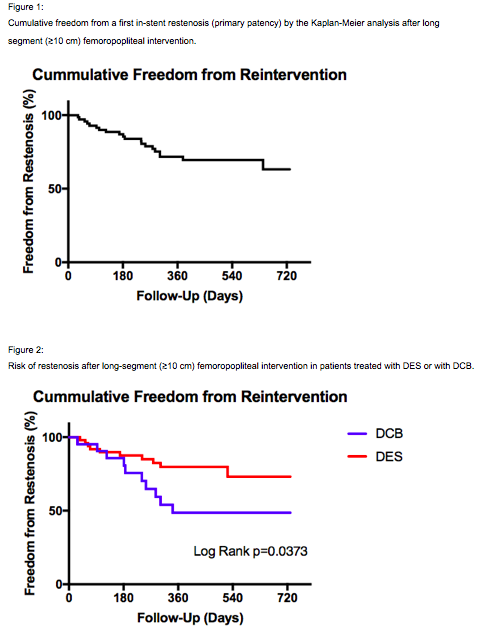Primary Patency of Long-Segment Femoropopliteal Artery Lesions in Patients with Peripheral Arterial Occlusive Disease Treated with Paclitaxel-Eluting Technology
Matthew Carnevale1, John Phair, MD2, Saadat Shariff, MD2, Larry Scher, MD2, Karan Garg, MD2.
1Albert Einstein College of Medicine, Bronx, NY, USA, 2Montefiore Medical Center, Bronx, NY, USA.
Primary Patency of Long-Segment Femoropopliteal Artery Lesions in Patients with Peripheral Arterial Occlusive Disease Treated with Paclitaxel-Eluting Technology
Objective:
The aim of this study was to evaluate the performance and predictors failure of paclitaxel drug-eluting stents and paclitaxel coated ballons for the treatment of femoropopliteal disease. We report a retrospective cohort analysis of patients at high risk for restenosis treated with paclitaxel eluting stents and paclitaxel coated balloons.
Methods:
Eighty-four consecutive patients with peripheral vascular disease (Rutherford III-VI) underwent long-segment (≥10 cm) femoropopliteal paclitaxel eluting stent (DES) implantation or angioplasty with paclitaxel coated balloons (DCB). Patients were followed after their initial procedure for target lesion restenosis, defined as a reduction in lumen diameter by greater than 50% as measured by duplex ultrasonography.
Results:
The median length of the affected arterial segments was 10 cm (interquartile range [IQR] 10-15, absolute range 10-26) using up to 4 overlapping stents. During the median 13-month follow-up (IQR 7-16), no early thrombotic reocclusions occurred within 30 days, but 21 (25%) patients developed a target lesion restenosis. Cumulative freedom from restenosis at 6 and 12 months was 87% and 71% overall, respectively. The cumulative patency during the same follow-up periods, varied between patients treated with different paclitaxel modalities with 88% and 80% freedom from restenosis in patients treated with DES (n=57) versus 81% and 49% in patients treated with DCB (n=27) (adjusted hazard ratio 2.46, p 0.03). Lesion length, concurrent tibial angioplasty and recurrent target lesions were not associated with restenosis.
Conclusion:
Midterm restenosis in patients treated with paclitaxel eluting stents and paclitaxel coated balloons remains a problem however this technology offers higher patency rates than non-drug interventions. The freedom from restenosis observed in patients treated with DES is significantly higher than patency rates in patients treated with DCBs. 
Back to 2019 Abstracts
